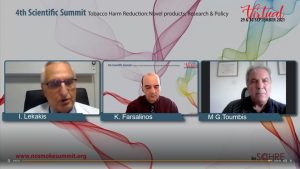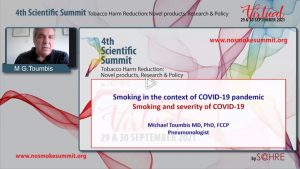The relation of tobacco use with risk of Covid-19, as well as the association between smoking and the severity of disease were discussed in a very interesting session, chaired by Professor of Cardiology and Director of the 2nd Cardiology Department at Attikon Hospital Ioannis Lekakis, on the second day of the Scientific Summit.
We know that smoking increases by far the risk for respiratory infections, Professor Konstantinos Farsalinos said, initiating his presentation; also, that this risk is depending on the number of cigarettes consumed daily and declines when people quit smoking, although it takes a long time after quitting for this decline to be considerable. So, it was expected that smoking or even other types of inhalable products, like e-cigarettes, would increase the risk for development of Covid or the risk for severity of Covid and complications related to the disease. However, Prof. Farsalinos said, surprisingly, the analysis of data on smoking among hospitalized Covid patients from Chinese case studies showed that only a very low proportion of those hospitalized were smokers, despite the high prevalence of smoking in China.
This impressive finding was followed, the speaker said, by findings from other studies, such as an Israel study which found that current smokers were about 50% less likely to be diagnosed with Covid; a UK large study that found that heavy smokers were less likely to be diagnosed with Covid and to be admitted to an ICU because of Covid, and a German study which showed that people who smoke more than 10 cigarettes per day were 72% less likely to be diagnosed with Covid. That, of course, doesn’t mean that smoking is protective, Professor Farsalinos added, and that it can be used as a preventive or protective measure against any kind of disease, since its serious adverse effects are well known. All these findings, he continued, led us to the hypothesis that not only nicotine but cholinergic agonists in general, such as varenicline which is used for smoking cessation, may play a possible protective role, and to the subsequent preclinical verification of this hypothesis using cholinergic (α7 receptor) agonists.
In conclusion, considering the several limitations of the data, smokers seem to be less likely to be diagnosed with Covid, Professor Farsalinos said, and fewer smokers than expected―based on population smoking prevalence―appear to be hospitalized for Covid, but smokers who actually were hospitalized for Covid are more likely to develop severe Covid or die. These findings, Professor Farsalinos again stressed, do not support in any case any role for smoking in the prevention or treatment of COVID or any other disease, but led to the generation of the cholinergic hypothesis, according to which cholinergic anti-inflammatory pathway controls the immune response and maintains immune balance by preventing cytokine storm.
Covid-19 has imposed on humans a new way of life, Dr Michael G. Toumbis said, a new way of living with health consequences. According the newly reported and cumulative Covid-19 cases and deaths, per WHO region as of 29 August 2021, 215 million cases and about 4.5 million deaths have been recorded until now, he pointed out. On the other hand, it is estimated that today there are 1.1 billion of smokers worldwide. Prevalence of smokers among Covid-19 patients is variable in several areas of the world, Dr Toumbis said, for example in China it is 9%, while in the USA and other countries it is around 20%. Describing the progression of Covid-19, Dr Toumbis explained that the disease has 3 stages, the first of which represents the early infection with SARS-Cov-2, the second is the pulmonary phase, where the symptoms emerge, requiring an outpatient visit or hospitalization of 24 hours or more, and the third stage is the hyper-inflammation phase, where disease progression becomes so advanced that it requires ICU admission or mechanical ventilation or results in death.
According to the findings of 12 cohort studies, the risk factors for very severe Covid-19 (requiring ICU admission) include several comorbidities, such as COPD, diabetes, CHD, stroke, arterial hypertension and malignancy, and smoking, Dr Toumbis pointed out, while a review and analysis of 13 more studies also included smoking among the risk factors for severe and deadly disease. Additionally, a systematic review and meta-analysis of 47 studies regarding the effect of smoking on Covid-19 severity concluded that current smokers had an increased risk of presenting to hospital with severe Covid-19 and were approximately twice as likely to experience severe or critical Covid-19 as former or never smokers, although this risk became non-significant following sensitivity analysis. For patients with a smoking history, he said, there was an increased risk of presentation to hospital with severe, as well as severe or critical Covid -19 and subsequent increased risk of in-hospital mortality; additionally, these patients were more likely to experience disease progression and require mechanical ventilation.
Another review and meta-analysis, Dr Toumbis said, found that younger smokers appear to have a higher risk of Covid-19 disease progression than older smokers, while other studies showed that smoking was associated with severe disease or critical outcomes, e.g. increased risk of admission to ICU but not with mechanical ventilation, and increased mortality; however, this association was more significant for former smokers than for current smokers, although current smokers also had a higher risk of developing severe Covid-19 compared with non-smokers.
Summarising the results of all mentioned studies, Dr Toumbis concluded that apparently there is a lower prevalence of smoking in Covid-19 infected patients; both current and former smoking significantly increase the risk of disease progression, severity and mortality, and current smoking is less likely to have negative outcomes compared with former smoking. Of course, Dr Toumbis underlined, well-designed population-based studies that control for age and relevant underlying risk factors and further causational studies on this association and the underlying mechanisms of this relation are warranted to confirm all these interesting findings.



